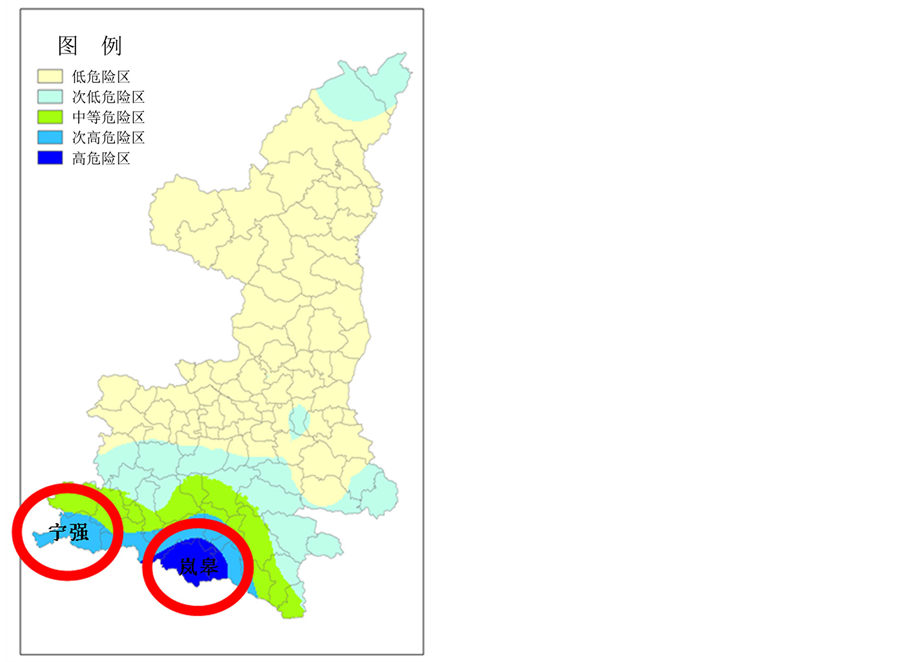1. 引言
位于中国西北部的陕西省是世界上气候影响最敏感的地区之一[1] 。近50年来已经经历了气候变化的影响,包括温度升高和降雨的减少,同时,暴风,干旱,洪水,暴雨,大雪,以及突如其来的霜冻和冰雹等极端天气事件变得更加频繁和激烈[2] -[6] 。这些不利影响对陕西农业和农村发展造成了显著的影响。
贫穷是气候脆弱性的主要驱动因素,因为穷人缺乏预测气候灾害影响的能力、缺乏减少风险投资的战略能力,也缺乏应对气候变化的能力和提高适应能力的手段,他们获得公共服务、进入社交网络和使用公共资源能力缺乏[7] -[10] 。因此,气候变化成为阻碍发展、公平和社会公正的问题[11] -[14] 。
事实上,农村社区面临包括干旱和洪水等众多气候影响。然而,气候变化将产生新的风险,改变我们曾经了解、制度有效地运行的总体状况以及我们的行为方式。农村社区要继续成功地适应气候变化就要基于更广泛的经济、社会、政府的支持[15] -[18] 。因此,农村贫困人口是否能够成功地适应气候变化在很大程度上取决于环境和政策来降低气候脆弱性 [19] 。
目前,国内有关农村贫困社区和人口气候脆弱性评估仅仅局限在生计资本或自然资源单一资本[20] [21] ,统计体系也没有反映其规模大小、地理分布、贫困特征,也没有气候与贫困有关的问题和性别适应气候变化战略或政策[22] [23] 。本研究目的是透过社区、家庭的脆弱性评估,填补国家及陕西省农村气候变化适应性空白。
2. 方法
脆弱性评估是在陕西不同气候脆弱区域[24] 选择7个农村社区进行了实地调查(图1),通过全体村民半结构访谈、绘出社区资源图、大事记、不同性别和人群分别绘出农事历与灾害种类及强度、应对措施、灾害排序与打分等参与式方法[25] ,分别找出社区自然资源资本种类、金融资本种类、农业气候影响关键因素和关键生计种类、通过社区关系图找出社会资本种类、入户访谈等方法获取物资和人力资本种类与数量。通过上述调研结果建立农村气候变化脆弱性评估指标体系(表1)。再根据可持续生计框架和多目标综合决策方法[26] ,分析和确定资本资产的积累与易受气候变化影响的生计区。
选择调查点的依据有三:一是调研地点必须在气候脆弱区(图1) [27] -[35] ;二是必须是贫困县或对照县:三是代表生态和产业结构。

Figure 1. The selecting location in different climatic zones (Wubao County and Shenmu Counties—drought vulnerability District in the Loess Plateau of Northern Shaanxi Province; Tongchuan and Changwu Counties—drought and semi-arid fragile area in Guanzhong of Northern and Western in Shaanxi Province; Ningqiang and Langao Counties—floods fragile areas in southern Shaanxi) (quote from the Shaanxi Provincial Meteorological Bureau)
图1. 不同气候区域选点图(吴堡县、榆林代表陕北黄土高原干旱脆弱区,铜川、长武代表关中北部和西部干旱半干旱脆弱区;宁强、岚皋县代表陕南涝灾脆弱区——引自陕西省气象局)。眉县为对照县、关中中部(未标注)
表1. 农村社区脆弱性评估重要指标体系(2012.08~2013.03 陕西)
3. 结果与分析
3.1. 陕西气候变化及对未来农业的影响
同全国一样,陕西省气候变暖趋势明显。年平均气温上升了1℃~1.6℃;降雨明显减少;平均降雨量减少10%~20%;极端天气事件更加频繁,强度加大,包括热浪、干旱、洪水、大雨、沙尘暴、冰雹和霜冻;夏季高温,已打破了历史纪录(陕西省政府,2008)。干旱更加频发,遭受旱灾的地区在不断扩大(Wei,2012),导致沙尘暴更加频繁,沙漠化加剧,地下水位降低。
未来气候变化的影响将随着时间的推移而加剧。气候变化已经并将继续对社会经济发展以及城市和农村居民的生计产生很大的影响(陕西省发改委,2011)。气候变化将使冬小麦产量平均下降10%~15%,玉米将下降3%~6% (J.Wang等,2011)。预计光照将增加,也会对农业会产生积极的影响,包括水果、玉米和小麦的生产将进一步向北扩展(J.Wang等,2011)。但这不可能抵消对产量的负面影响以及因灾害造成的歉收。
此外,气候变化对水资源将产生严重影响,因为干旱和降雨减少使得河水流量减少。根据IPCC的资料,气温上升1℃,灌溉用水就要增加6%~10%。对于陕西省来说将面临缺水15亿立方米,包括农业缺少7~8亿立方米(Min和Han,2008)。2020年,预计缺水达到35亿立方米(Min和Han,2008)。
3.2. 农村脆弱性与适应能力分析
3.2.1. 农村社区对气候变化影响的认识
在所调查的乡村中,村民们都经历了逐渐升高的气温与更多变的天气(表2)。由于气候变化、发展政策和制度等综合影响,农业生产已经严重萎缩,降低了农业收入与粮食安全性。降雨类型的变化导致在农业生产关键时期降水过多或过少。在陕北和关中,干旱导致作物与水果最高减产达70%,家庭收入也因此相应缩减。由于陕南农村农田排水系统缺乏或不畅,暴雨淹没农田,毁坏幼苗,甚至导致庄稼颗粒无收和次生灾害[35] [36] 。在宁强2012年至少有70%的玉米因暴雨而减产,导致饲料来源减少。在吴堡2012年早春的降雨影响了枣树授粉;冬季相对温暖,又使越冬病虫害基数增加,加剧了病虫害,进一步影响了收成;枣树生长需水时期恰逢最干旱的时节,延缓了栆的生长;而收获季节则频繁降雨,导致成熟的枣开裂,减产70%~90%,进而影响其价格。气候变化使作物减产,农民已经不再种植某些作物或果树,虽然这些作物与果树曾给他们带来过稳定的收入。
3.3. 农村社区对气候变化的自发应对和适应策略
气候变化对农村社区、农户生计的影响是显而易见的,农民们对此已经适应。调查发现:农户所作的适应气候变化的决定是根据收入与政策、制度支持体系进行的:适用气候变化的策略包括改变耕种时间、用其他作物替代、使用抗旱、抗病虫品种,修建排水沟渠。在铜川、长武小麦播种时间提前了7~15天。为应对干旱的气候,陕北、关中农户采用包括地膜玉米、地膜小麦、在土壤上铺一层碎石等措施适应干旱。吴堡农民用水车来灌溉土地,但由于水资源缺乏,不是长久之计。农户用国家的农资补贴普遍用上抗旱抗病虫害品种和地膜等。然而,这些补贴不足以使贫困家庭负担相应的成本。神木农民用塑料水管将水从灌渠中引出以减少蒸发。所有这些措施既费时又费力。对于贫穷家庭无力投资,限制了他们适应气候变化不利影响的能力,导致贫困加剧。这一证据表明,如果有恰当的工具与社会保障网,农民们可以应对风险。
3.4. 农村社区应对气候长期变化的措施
由于市场经济的调节,传统的粮食作物已经被更为集约的经济作物与饲料作物的农业系统所替代,政策与气候变化的综合作用使农业产业结构和作物布局已经发生了变化:干旱的陕北农民已经停止了荞麦、小麦等禾谷类的种植;陕南由于持续的降水和玉米种植可得到政策上的支持,农民放弃了小麦转向大量生产周期更短的玉米等作物,以避开春季的霜冻[37] 。神木部分家庭开始种植树苗,以弥补谷物减产的损失(表3)。
种植制度已经适应了天气的变化。在岚皋县农民们已经放弃了油菜的种植和桑蚕的养殖。因为新品种油菜受降雨的影响,产量降低;老品种虽然抗病性较好,但产量更低;家蚕需要较长的生长期以及温暖干燥的天气。这些因素与市场的驱动一起,导致了小麦价格低、桑蚕价格不稳。
3.5. 农村社区气候变化背景下的人口流动
随着气候变化更加无常,农户家庭的收入来源也多样化。农民外出打工的收入是农业收入的两倍之多。农户家庭已经对这种收入模式产生了依赖。在所有的调查村庄中,大部分外出打工的是男性(表4)。
劳动力流动的机遇与挑战并存。首先,增加了家庭的收入并且可以缓解气候变化造成的极端天气影响;然而,依赖打工收入来源的家庭容易受到波动,农业生产劳动力减少;而留守的农民无法在其有限的土地上获得足够的收入,同时也由于劳动力与其他资源的缺乏,很多家庭的适应策略已经变得不可行。例如,牲畜的饲养是可能的收入来源,然而由于劳动成本较高,不得不放弃。劳动力的流动同样造成了

Table 2. The impact of climate change to the villages and the villagers demand
表2. 气候变化给各村带来的影响和村民的需求

Table 3. The rural community, its risk coping strategies and adaptation strategies in the face of climate change
表3. 农村社区面对气候变化的风险、应对策略和适应策略
女性负担的加重,她们不仅需要留守在家照看老人与儿童,同时还要照料农田。
3.6. 社区农户面临的气候变化挑战及获得制度上的支持
3.6.1. 气候信息的获得
农民通过不同的渠道获取天气信息,包括电视、电台、村庄广播系统等,有些还可以接收气象局或

Table 4. The proportion of women in rural communities and in migrant workers
表4. 陕西农村社区外出打工的比例与女性外出打工所占比例
省防洪办发出的短信,电视是信息传递的最可靠方法。有些家庭参照气候信息制定耕作计划。然而,有些农民抱怨缺乏山区精确的气象信息,如天气预报仅仅能否预报到霜冻出现的大致时间,但不同的地块、种植制度等不同,这样的预报实际应用的意义不大。天气预报对短期计划很有帮助,却无法向农民提供长期生产规划决策的相关气候信息。由于缺乏预报霜冻的精准信息,农民很难采取预防性措施保护作物。农民或村干部不知晓有关长期气候趋势的气象信息,因此只能依照过往的经验进行决策,而这已经不再可靠。
3.6.2. 灾害管理
随着极端天气事件越来越频繁,大部分调查村庄中并没有建立应急方案或语境系统。村民们感觉他们并没有能力应对灾害并避免受到气候事件的影响。目前,农村社区发展规划与极端天气事件的增加并不相符。村干部对村中容易受到灾害影响的区域了如指掌,然而没有能力去解决资金和政策、制度上的问题。这表明,目前我们不仅需要规划,还需要一个灵活且循环的规划体系,以解决社会问题以及与气候引起的变化相关的问题。在铜川、岚皋的两个村庄有气象大喇叭应急方案,可以为在可能遭遇极端天气事件的村民发出预警。其他五个村中的大部分应急方案资源都用于应急救助与灾后重建。对农村房屋修葺进行补助政策是具有适应气候变化的长远眼光的政策之一。
3.6.3. 农村社区的用水供水系统
在所有的受调查村庄中,水资源的利用都是一个大问题,影响着村民的生活质量以及农业的可持续性。在七个村庄中,有五个位于半干旱气候中。不同的村庄之间,水资源的利用、可用度以及基础设施与需求都不尽相同,而现有的基础设施与管理体系明显不足。神木县高圪堵村是调查村庄中具有灌溉设施的村庄。然而,此设施需要各家轮流使用,即便是在陕南两个村庄中,虽然一年中大部分时间降水都比较充足,但是水资源的分布依然不均衡。有些家庭已建造水窖收集雨水以弥补水源不足,有些村庄还有一套从邻村调水以补足水需求缺口的非正式系统。如宁强罗全岩村四组2010年安装了自来水,而另外三个组则使用水窖来收集雨水作为饮用水,当水窖水不足时去到四组调水。由于水资源有限,需求越来越大,且气温升高蒸发加剧,所以,对水资源的管理则显得至关重要,因曾有社区为用水村民之间发生殴斗等社会不安现象。
3.6.4. 农业支持系统
政府通过农业补贴、保险、农民专业合作社等方式对农民进行扶持,以缓解缓解气候风险。然而,由于执行机制的不充分,最需要扶持的村民往往从中受益有限。除了眉县调查村外,其他所有村庄都要面临市场的挑战。供应链中中间人的力量、小农经济、道路设施的不足以及合作社运作效果等因素影响了农业产品的价格以及农民参与定价的能力,减少了农民的家庭收入。调查中有五个村庄建立了合作社,眉县的合作社在开发市场以及定价方面是较为成功的,但是合作社由农村中地位突出的人管理,贫穷的农民被边缘化。其他合作社的规模较小,大多没有在官方注册或者并没有建立利益分享机制,社员担心入股资金安全问题。由此可见,如果没有政策和资金扶持,合作社进行共同投资、清除市场障碍以及风险共担等能力仍然是一个大问题。
在铜川安村,农民很难通过农村信用社获得信贷,很多村民至今仍然依靠不正规的贷款网络进行资金筹措。表明:农民们缺乏满足基本农业需求的备选筹资渠道。在长武,村庄内部建立“基金互助合作社”,以简化贷款流程,然而村民认为其并没有发挥应有的功能。对于年龄超过60岁的农民而言,获得信贷尤为困难,而这些人是社区需要资金支持的最主要的社会群体。
调查发现,很多农民都要求培训,然而并没有特别技术与最佳管理实践进行培训的机制。在岚皋、铜川等地,农技部门对核桃、板栗的种植提供了培训,对象主要是农村主要劳动力——妇女。
3.6.5. 适应能力建设
调查结果表明,农村中最容易受到气候影响的群体为最贫困的、主要依赖于农业收入的妇女、儿童以及老人,他们是在主要留守群体[38] 。这种脆弱是由村庄外部更大的社会、政治或经济体系而引起的,限制了家庭层面的应对能力。因此,需要在这些村庄中帮助村民建立适应能力,以保证他们更好地应对气候变化以及快速变动的农村社会的其他风险。
农村合作医疗是农村发展的基本需求与社会保障,所调查的村庄都已经建立了农村合作医疗系统,但需要政府进一步的投资和职能部门与人员的尽责。所调查的贫困山村迫切需要基本水资源和道路等基础设施投入,因为他们的基础建设投资远远大于其他地区:平川修1 km道路,10万元打底子(砂石路)在贫困的秦巴山区却要40~50万。
适应能力比基础设施更难实现,并且需要考虑村庄之内、之间以及乡村与城市中心等的不均衡性。社区的能力与社会的凝聚力也是适应能力的重要指标。在宁强,村民们在危机时彼此帮扶,并且与邻居以及社区一起共同利用资源。村庄中,行政管理部门同样也是支持的来源。个别村庄缺乏此类社区网络,在解决社区所面临的种种挑战时,村民们感觉到无助。虽然村民们面对气候风险已经采取了应对措施,但没有可体现优先级以及决策机制。在社区重大决策时,妇女通常因家务等不能参与而被排除在外。由于目前大部分留守村民都为妇女,这一问题日益严峻。在决策中,应当听到妇女的呼声。
4. 结论
陕西省农村社区的适应能力因气候变化以及同时发生的经济、社会和政治变革所带来的重大影响密切相关。气温上升、降水量减少,影响了雨养农业的需水与用水。极端天气事件的频发和强度加大还造成了巨额的社会经济成本,其中包括毁坏房屋、作物和影响人们生产生活的干旱、洪水、沙尘暴和风暴。小气候的变化将影响病虫害的入侵和大发生,从而影响陕西省果业、农业的发展。然而气候变化影响各村之间以及同一个村之内明显不同,其在风险和适应能力方面的差异使得脆弱性也呈现不同的特点。
在气候不确定性日渐严重的当今,农村社会在农业结构、减少劳动力流动限制以及增加基础设施与公共服务方面都发生了变化。由于气候变化与市场的共同作用,所有的乡村都需要劳动力流动来弥补农业收入的缺口。当前及未来气候影响逐渐加剧,贫穷、健康状况差以及水资源的缺乏与制度的缺乏等复杂、多重因素的共同作用导致了农业易受气候变化的波动,因此,农村社区与社区组织的能力对于实现适应气候变化至关重要[38] 。
适应气候变化的政策与实践之间显著存在缺口,不仅中国,全球范围亦是如此。政策的制定应该更加符合本地实际情况。关于气候变化的认识仅停留在专有部门和理论界。政府将农业适应定位为“增加农业的适应能力以确保粮食安全”,通过开发耐干旱品种,去除影响粮食安全的多种要素影响,让农户切实参与粮食的经济与实际操作等干预措施。这种重新定位需要物价支持、信用使用以及社会保障等方面政策的支持。而这首先要满足最容易受气候变化影响的农户的适应性需求,尤其是那些依赖于农业的家庭以及贫困者、妇女、儿童与残疾人。实际上,气候的脆弱性正在恶化着这些群体目前易受影响的情况,让本已举步维艰的生活更加困难,因此需要更多的支持。
陕西省已经在制度上具备了解决这些农户适应变化需求并进行执行的能力,虽然目前仍然处于起步阶段,需要将当前的工作与当前的管理架构通过恰当的合作与协作等刺激因素与平台进行关联。
灾害管理需要整合到发展目标中,对于适应能力的规划将确保气候风险在现有策略的控制之下,气候适应方案同时需要考虑灾害的性别影响,有确切证据表明,女性比男性更容易遭受风险,而这一涟漪效应将会扩散到整个社区。
实施证明,如果没有政府有针对性的措施与规划,一些创新措施很少传达到那些易受影响的群体中。与《中国应对气候变化国家方案》中所列出的大规模干预措施相比,小农经济需要不同的灌溉与水资源管理实践。由于水资源的使用是整个陕西省以及所有被调查村庄所面临的问题,水资源的管理成为重中之重。适应性是一个多层面的任务,当地政府需要采取有效措施以帮助家庭应对气候风险。鉴于农户的气候脆弱性高,而主要适应政策领域为农业、水资源和灾害管理,适应策略应当更集中于农村社区,同时对农户的投入是实施有效政策干预所必不可少的。
5. 建议
5.1. 综合适应气候变化策略的制定与协调
通过评估长期与短期气候风险的叠加过程,将适应措施纳入开发、农业、灾害与水资源规划中通盘考虑;对削弱当地男性与女性适应能力的气候风险进行评估;创建可以听取易受影响群体(尤其是老年人与妇女)声音的机制,以对支持农村响应与适应能力的措施进行整体设计;建立具有创新灵活结构的资金扶持渠道,鼓励民间社团以及研究机构参与,并推行政府部门间的横向协作。
5.2. 从气候信息的传播到气候知识的普及
提高跨部门获得并分析气候数据的能力并形成相关的制度,以便为所有层面上的决策提供信息;创建学习、共享与培训机制,以确保所有的相关机构都可以获得信息与知识,并且使信息符合各利益相关方的要求,同时在恰当的时机以恰当的形式提供。政府官员以及部门与社区的培训与能力建设;在政府机构、民间机构以及致力于适应实践执行的地方团体之间建立本地网络,以创造共享、学习与获得知识的平台。
5.3. 减少灾害风险
根据气象信息与预测,优先提升农户以及农村社区适应长、短期极端天气事件的能力;整合所有层面的发展、气候变化适应与灾害规划,用于对现在及将来的气候变化与社会经济学风险指标的评估;扩大社会保障网络,提高效率;通过强化相关政府机构之间、民间组织以及乡村的协作,实现跨部门学习、分享与提高适应气候变化的能力;根据对社区技能与资源的充分评估,设计政策激励机制,鼓励采取经过实践检验的好经验,如耐干旱品种的引进、土壤修复、生态农业以及生计多样化等。
5.4. 水资源与利用管理
对短期和长期家庭与农村社区水资源利用与可用度进行评估,以制定协调的水资源管理方案与实践;提升并支持乡村层面的能力与权限,以对水资源进行可持续的公平管理,进而强化极端缺水社区的适应能力;开发并执行经过验证的工具与管理措施,以提升对水资源的本地管理以及解决用水冲突的能力,例如建立有效的水资源协会并对其行为进行监督与审查等。
5.5. 发挥农业扶持系统的作用
易受气候变化影响的群体对农业扶持系统有优先使用权;评估本地对信贷、协助以及补贴的需求,以提高适应能力,尤其是妇女与老年人的适应能力;推行有效的合作社组织,以减少家庭的风险与费用、增加收入、提高生计的可靠性与投资能力并将合作社的发展与社区的需求与政府的方向密切结合;开发对服务进行拓展的机制,以对本地需求进行评估与响应。
5.6. 提升适应性与适应能力
对农户多维度脆弱性进行评估,以设计、执行并评估可以增加当地居民生计资产的能力;执行相关政策,以增强当地凝聚力与适应性,如提供教育、卫生保健,让男性与女性都可以参与公共投资决策等。强化农民工及其家庭成员(如留守的老年人、儿童与妇女等)的社会保障体系;为职业技能的提升提供便利,以实现谋生手段的多元化。
6. 讨论
本研究的重点是农业生计的脆弱性以及为解决此种脆弱性的制度能力,另外还有气候变化对健康的影响以及为解决气候风险而建立的各级民间组织。本研究期望为省政府制定未来的适应政策提供理论依据。
重要的是陕西农村社区正面临多种风险以及环境和社会发生的重大变革。气候变化只是加剧农村社区脆弱性的许多影响之一,不可能将气候变化的影响与其他因素分离开来。
由于不同人共同利用参与式方法进行农村入户调查,各个村的条件不同,时间安排不同,有关风险认识问题可能也有差异,包括一些偏见。向农户询问有关收入的问题通常难度很大,有关支出和收入的数据很有可能被夸大。为了了解其他创收途径,调查中还增加了一些问题,包括农业机械、住房类型和圈养动物种类。从重点群体和入户调查的资料看,最脆弱的显然是那些最默默无闻并且通常在理解和回答问题方面有困难的群体。这个群体通常需要求助于其他家庭成员来回答问题,这样的回答并不完全是他们自己意愿的表达。